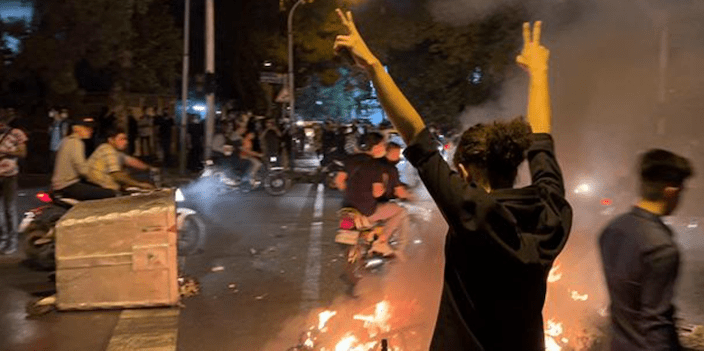Michael Young: The ongoing protests in Iran are only the latest in a series of protests that have taken place during the past months and years. What does this tell us about the system in place in the country, and even its survival?
Ali Fathollah-Nejad: Indeed, the Islamic Republic of Iran has been shaken by a tsunami of protests over the last half-decade, including anti-regime nationwide uprisings as well as thousands of social protests. This demonstrates the mounting and widespread frustration with the regime and the latter’s continued incapability to cater to the population’s most basic needs. This has resulted in permanent instability because of recurrent popular protests and violent crackdowns in response. Not only has regime stability been imperiled, but also its very survival, with the political and security establishment understanding that the prime threat emanates from inside the country, not outside.
This realization occurred with the Dey protests at the end of 2017 and into 2018, which provoked a shock among the elite, with its de facto continuation in the November 2019 Âbân protests. In both uprisings, for the first time, the lower classes took to the streets en masse. They had been conventionally considered the regime’s social base, or at least loyal to it. During the Dey protests, 50,000 people demonstrated, while 200,000 did so during the Âbân protests, according to the Interior Ministry. Both upheavals were initially sparked by socioeconomic degradation, but quickly turned political. The slogans targeted all components of the Islamic Republic—both the clergy and the Islamic Revolutionary Guard Corps, or IRGC, and both the hardline and reformist factions of the establishment—spreading to all corners of Iran like wildfire, engulfing about 100 cities and towns.
I have argued that these uprisings reflected an Iranian version of a “long-term revolutionary process.” They very much were like what we saw in the Arab world, the so-called Arab Spring upheavals with their continuing waves. They were, likewise, driven by a combination of socioeconomic misery and political authoritarianism, as well as an unwillingness by those in power to reform.
In addition, we have been witnessing thousands of protests over the last few years, from a great variety of social groups. In 2021 alone, the ACLED database (which, however, doesn’t include Persian sources) counted 4,000 protests—a record number since 2016—and in the first half of 2022 more than 2,200 protests. This is just an indicator of the widespread dissatisfaction with conditions in Iran. These protests were driven by what I call the Islamic Republic’s “triple crisis”—socioeconomic, political, and ecological—of which the political crisis constitutes the center of gravity. After all, Iran’s ruling oligarchy monopolizes both political and economic power, and there is little likelihood of overcoming the country’s multifold crises without political change.
This situation has translated into an increasing frequency of protests: From the 1999 student uprising, to the 2009 Green Movement, to the Dey protests, to the Âbân protests, to where we are today. While the Dey and Âbân street protests were not joined by important parts of the middle class, we are now witnessing the broadest social composition of any uprising so far. Women and the young are at its forefront, showing remarkable courage and resolve, because Mahsa Amini’s murder has hit a nerve among the lower and middle classes alike, accompanied by quite remarkable cross-ethnic solidarity and a strong university presence. Now, workers and celebrities have joined in as well. This has truly become a national revolt, posing a serious threat to the regime, explaining the brutality of its response.
During the last two nationwide uprisings, an intersectional alliance was missing. Now, we are seeing it, and it is a process that has also been facilitated by the impoverishment of the middle class (the growing ranks of the “middle class poor”) over the last few years. The middle class no longer feels that stability at any cost necessarily serves its interests, as it is facing high unemployment, especially among women, graduates, and the youth. As a result, “bread” and “freedom” issues have become inextricably linked.
MY: In a recent article, Carnegie scholar Karim Sadjadpour was quoted as saying that the Islamic Republic of Iran has three remaining ideological pillars—Death to Israel, Death to America, and the hijab. Do you agree, and, if so, what does this tell us about the religious-cultural pillars, but also the fragility, of the regime?
AFN: As usual, he is on point. One cannot imagine an Islamic Republic without these core tenets. Yet, a post-Khamenei Iran may, for the sake of regime durability, relax some of the religious-cultural restrictions that collide with general public sentiments, adapt to an increasingly secularized society, and accommodate widespread popular rejection of politicized religion and the ruling clergy.
MY: How would you compare the cycle of protests taking place in Iran today to the protests that took place against Shah Mohammed Reza Pahlavi in the late 1970s? At the time, the authorities were caught in a cycle of protests from which they were unable to extract themselves, until the shah fled. How have the protests under the Islamic Republic been different, leading to different outcomes?
AFN: In the 1970s, Iran’s revolutionary movement was pluralistic and united in its opposition to the shah. Also, a considerable factor in the shah’s overthrow was that his foreign backers had largely abandoned him. The main difference between now and then, however, may be the level of public awareness. Today, the internet, despite its negative tendencies, has opened horizons that can be used for a more informed public. The starker difference, though, is the present regime’s willingness to use barbaric violence to hold on to power, despite all odds, far outweighing the shah regime’s brutality during its dying days.
Yet, the greatest hope lies in the fact that today many Iranians have an understanding of the importance of human rights—a result, not least, of unprecedented human rights violations during the four-decade rule of the Islamic Republic. There is also an understanding of the importance of women’s rights, which is on display today.
In contrast, probably the single most important shortcoming of the pre-1979 revolutionary movement was the dominance of a facile anti-imperialist, anti-American zeitgeist that had effectively marginalized any concerns for human or women’s rights and democracy.
MY: There has been much speculation about who might succeed Ayatollah Ali Khamenei, who has been in poor health lately. Is it your feeling that a succession plan is in place, and how might the ongoing protests in the country play into this?
AFN: There are many unknowns so far, both regarding domestic forces and the position of foreign backers. Yet, we can assume that the IRGC is doing everything in its power to maintain its “full-spectrum dominance” in a post-Khamenei Iran, ideally with a weak successor as supreme leader who no longer holds the extraordinary powers that Khamenei has amassed. The power of the Shia clergy could well be reduced, translating into a system in which Iranian nationalism becomes the main ideology, superseding Shia nationalism and Islamism.
However, there is also a split within the IRGC between those with Shia and secular leanings. In brief, Iran could turn into a de facto military dictatorship, with the present ideological mix of Islamism and nationalism tilting toward the latter, in other words toward nationalism. Moreover, the positioning of Tehran’s main external supporters, above all Russia, will be a significant factor.
Also, a post-Khamenei Iran may be more lenient regarding social restrictions, not unlike what is taking place in Saudi Arabia under Crown Prince Mohammed bin Salman.
Yet, this doesn’t mean that popular opposition to a modified regime would be less strong, as Iranians have come to realize that the clergy and the IRGC are two equal evils. I
In other words, the “long-term revolutionary process” may well continue in a post-Khamenei Iran.

